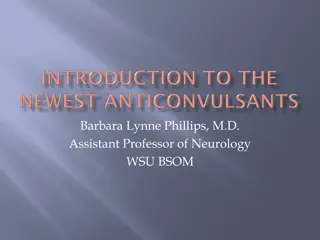Understanding Barbiturates: History, Types, and Mechanism of Action
Barbiturates are derivatives of barbituric acid, acting as depressants on the central nervous system by potentiating GABA. First synthesized in 1864, they have a rich history in medicine. Types include Amobarbital, Phenobarbital, and Pentobarbital. The synthesis of barbituric acid involves a condens
0 views • 28 slides
Understanding the Importance of Warm-Up in Exercise
Explore the significance of warm-up exercises in preparing the body for physical activity, including components like joint mobility, muscle activation, and cardio-respiratory readiness. Learn about the R-A-M-P approach for effective warm-up routines, focusing on raising body temperature, activating
3 views • 19 slides
Understanding Nerves and Muscles Physiology - Lecture Insights
Explore the intricate processes of synaptic transmission, neurotransmitters, spatial summation, temporal summation, chemical substances acting as neurotransmitters, and the effects of various factors and drugs on synapse function. Delve into the clinical significance of sedative-hypnotic drugs and t
0 views • 11 slides
Patterns of Pregabalin Use among People Who Inject Drugs in Australia
This study explores the patterns and correlates of pregabalin use among individuals who frequently inject drugs in Australia. Pregabalin, a GABA analogue with analgesic and anti-convulsant effects, has been increasingly used and misused in the country. The research aims to identify prescribed and no
0 views • 16 slides
Role of Presynaptic Inhibition in Stabilizing Neural Networks
Presynaptic inhibition plays a crucial role in stabilizing neural networks by rapidly counteracting recurrent excitation in the face of plasticity. This mechanism prevents runaway excitation and maintains network stability, as demonstrated in computational models by Laura Bella Naumann and Henning S
0 views • 13 slides
Comprehensive Overview of Propofol: Mechanism, History, and Pharmacokinetics
Propofol is a widely used IV hypnotic with a unique mechanism of action involving GABA receptors and dopamine modulation. Its history, from initial anaphylactic reactions to current emulsion formulations, is intriguing. Understanding its pharmacokinetics, including metabolism in the liver and kidney
0 views • 59 slides
Understanding Anticonvulsant Drugs in Pharmaceutical Chemistry
Anticonvulsant drugs play a crucial role in managing epilepsy, a common neurological disorder characterized by recurrent seizures. This article discusses the classification of epileptic seizures, mechanisms of action of anticonvulsants, and the role of GABA A receptors as targets for anticonvulsant
0 views • 27 slides
Neurology Insights: Lacosamide Trials and Treatment Targets
Dr. Barbara Lynne Phillips, Assistant Professor of Neurology at WSU BSOM, has expertise in lacosamide trials and treatment targets focusing on ion channels, GABA/glutamate, and other areas. Her main disclosures include participation in Phase II and III trials of lacosamide, a notable medication in t
0 views • 19 slides
Understanding Schizophrenia: Insights from Carlsson et al.'s 2000 Study
Carlsson et al.'s 2000 study on schizophrenia explores the dopamine hypothesis, highlighting the interplay of neurotransmitters like glutamate, serotonin, and GABA. They suggest future drug treatments for schizophrenia, emphasizing the need to consider neurotransmitter interactions beyond dopamine.
0 views • 17 slides







